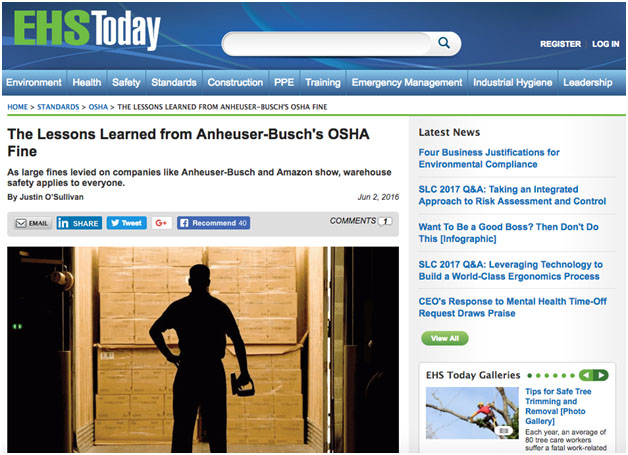No, but several pieces of legislation and government guidance suggest they are a good idea. HSE’s guidance mentioned above recommends yearly inspections from a SEMA approved racking inspector and regular racking inspections from competent staff.
Then there are the Provision and Use of Work Equipment Regulations 1998 (PUWER). These regulations outline the need for work equipment — which includes racking — to be inspected after installation or if the equipment is damaged in any way.
Finally, there is EN 15635. This European standard states that racking should be inspected by an expert at least once a year. This mirrors HSE’s advice on the topic. Though this European Standard doesn’t mention SEMA approved racking inspectors specifically, HSE does and so using SEMA approved racking inspectors for your expert inspections will be enough to comply with this European Standard.
Once again, the answer is no. However, HSA — the Irish body responsible for public health and safety — references HSE’s HSG76 in its guidance on warehouse safety. In that sense, HSA also recommends SEMA approved racking inspections and regular staff inspections as well.
Ireland is also subject to the same European Standards that the UK is, which state that racking should be inspected by an expert at least once a year.
A SEMA approved racking inspector is someone who has passed enough rigorous testing from SEMA to receive a SEMA approved inspectors qualification. At the time of writing, there are only 109 SEMA approved racking inspectors in the world, with inspectors operating in the UK, Ireland, Spain, Poland, Finland, the UAE, Singapore, and China.
Alongside the SEMA approved inspectors qualification, SEMA also runs cantilever racking inspection training. This top-up training course is designed for SEMA approved racking inspectors who also want to be experts on cantilever racking inspections. Only 34 of the 109 SEMA approved racking inspectors have passed both courses. Justin O’Sullivan (the founder of Storage Equipment Experts) is one of those people.
SEMA (the Storage Equipment Manufacturers Association) is the private body responsible for guidance and industry standards on all things related to storage equipment. They work closely with HSE and their advice is often referenced by HSE.
The SEMA Code of Practice is not one but several different documents by SEMA which outline best practice on warehouse safety. Each one can be purchased separately from the SEMA website. For free guidance, refer to HSE’s HSG76. For guidance on a specific issue, HSE may recommend a specific SEMA Code of Practice.
HSE (Health and Safety Executive) is the official government body responsible for health and safety at work, but sometimes public health and safety as well. They often work with SEMA and other organisations to write health and safety law and to offer guidance on all things related to health and safety.
The CDM Regulations, or the Construction Design and Management Regulations 2015, are a set of regulations which aim to simplify the old laws surrounding health and safety on constructions sites.
With regards to racking inspections and storage equipment safety, the most important things to know are that the new CDM regulations mean that a warehouse now counts as a construction site and that the owner (or the person responsible) for a warehouse is the “client”.
Legally, it is the client’s responsibility to guarantee everyone’s safety — including visitors — and to make sure that anyone working at the warehouse is competent enough to do so. It is also the client’s responsibility to judge for themselves whether or not someone is an expert. This is yet another reason why SEMA’s labelling of SEMA approved racking inspectors as experts in HSG76 is so important.
There are different kinds, but it often refers to training from a SEMA approved racking inspector designed to help warehouse employees perform the regular inspections which HSE recommends.
HSE states that people who perform these inspections should be competent. What is more, the CDM regulations mean that it is a warehouse owner’s legal responsibility to ensure that the staff inspecting their racking are competent. This is why we provide racking inspection training from a SEMA approved racking inspector — to make sure that the people performing regular staff inspections are competent.
Pallet racking and cantilever racking are two different kinds of racking system. Most racking systems are pallet racking systems, and that’s why SEMA approved racking inspectors specialise in that kind of racking system.
A pallet racking system uses pallets as shelves which can be adjusted vertically to store objects.

However, warehouses which are used to store long thin objects (usually timber) often use cantilever racking instead. Cantilever racking uses arms, rather than shelves, to hold up objects. The system also operates on a cantilever principle. That is to say, the upright is in the middle with two arms pointing out at either end to hold objects. Sometimes, however, the cantilever arms only point out at one end.

Yes, you can. Click on the link below.
Having performed racking inspections for the Tate Modern, Pinewood Studios, Dunlop, and many other small, medium, and large businesses across the UK and Ireland, we have a depth and breadth of experience like no other. Our customer testimonials speak volumes for the quality of our service.
With one of the only SEMA approved racking inspectors to have also passed the SEMA cantilever racking inspection course, we are able to provide a level of insight and rigorousness which our competitors cannot.
We are also passionate about the health and safety industry in general. We have provided insight on safety and business for a wide variety of national and international publications, including the Telegraph, EHS Today and Small Business.




